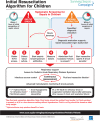Updates on pediatric sepsis
- PMID: 33145549
- PMCID: PMC7593454
- DOI: 10.1002/emp2.12173
Updates on pediatric sepsis
Abstract
Sepsis, defined as an infection with dysregulated host response leading to life-threatening organ dysfunction, continues to carry a high potential for morbidity and mortality in children. The recognition of sepsis in children in the emergency department (ED) can be challenging, related to the high prevalence of common febrile infections, poor specificity of discriminating features, and the capacity of children to compensate until advanced stages of shock. Sepsis outcomes are strongly dependent on the timeliness of recognition and treatment, which has led to the successful implementation of quality improvement programs, increasing the reliability of sepsis treatment in many US institutions. We review clinical, laboratory, and technical modalities that can be incorporated into ED practice to facilitate the recognition, treatment, and reassessment of children with suspected sepsis. The 2020 updated pediatric sepsis guidelines are reviewed and framed in the context of ED interventions, including guidelines for antibiotic administration, fluid resuscitation, and the use of vasoactive agents. Despite a large body of literature on pediatric sepsis epidemiology in recent years, the evidence base for treatment and management components remains limited, implying an urgent need for large trials in this field. In conclusion, although the burden and impact of pediatric sepsis remains substantial, progress in our understanding of the disease and its management have led to revised guidelines and the available data emphasizes the importance of local quality improvement programs.
Keywords: antibiotic management; fluid resuscitation; pediatric; sepsis; sepsis risk factors; septic shock; severe sepsis.
© 2020 The Authors. JACEP Open published by Wiley Periodicals LLC on behalf of the American College of Emergency Physicians.
Figures
References
-
- Fleischman‐Struzek C, Goldfarb DM, Schlattmann P, et al. The global burden of paediatric and neonatal sepsis: a systematic review. Lancet Respir Med. 2018;6(3):223‐230. - PubMed
-
- Weiss SL, Balamuth F, Chiutti M, et al, Sepsis Prevalence, Outcomes, and Therapies (SPROUT) Study Investigators and Pediatric Acute Lung Injury and Sepsis Investigators (PALISI) . Identification of pediatric sepsis for epidemiologic surveillance using electronic clinical data. Pediatr Crit Care Med. 2020;21:113‐121. - PMC - PubMed
-
- Schlapbach LJ, Straney L, Alexander J, et al. Mortality related to invasive infections, sepsis, septic shock in critically ill children in Australia and New Zealand, 2002–13: a multicentre retrospective cohort study. Lancet Infect Dis. 2015;15(1):46‐54. - PubMed
Publication types
Grants and funding
LinkOut - more resources
Full Text Sources

